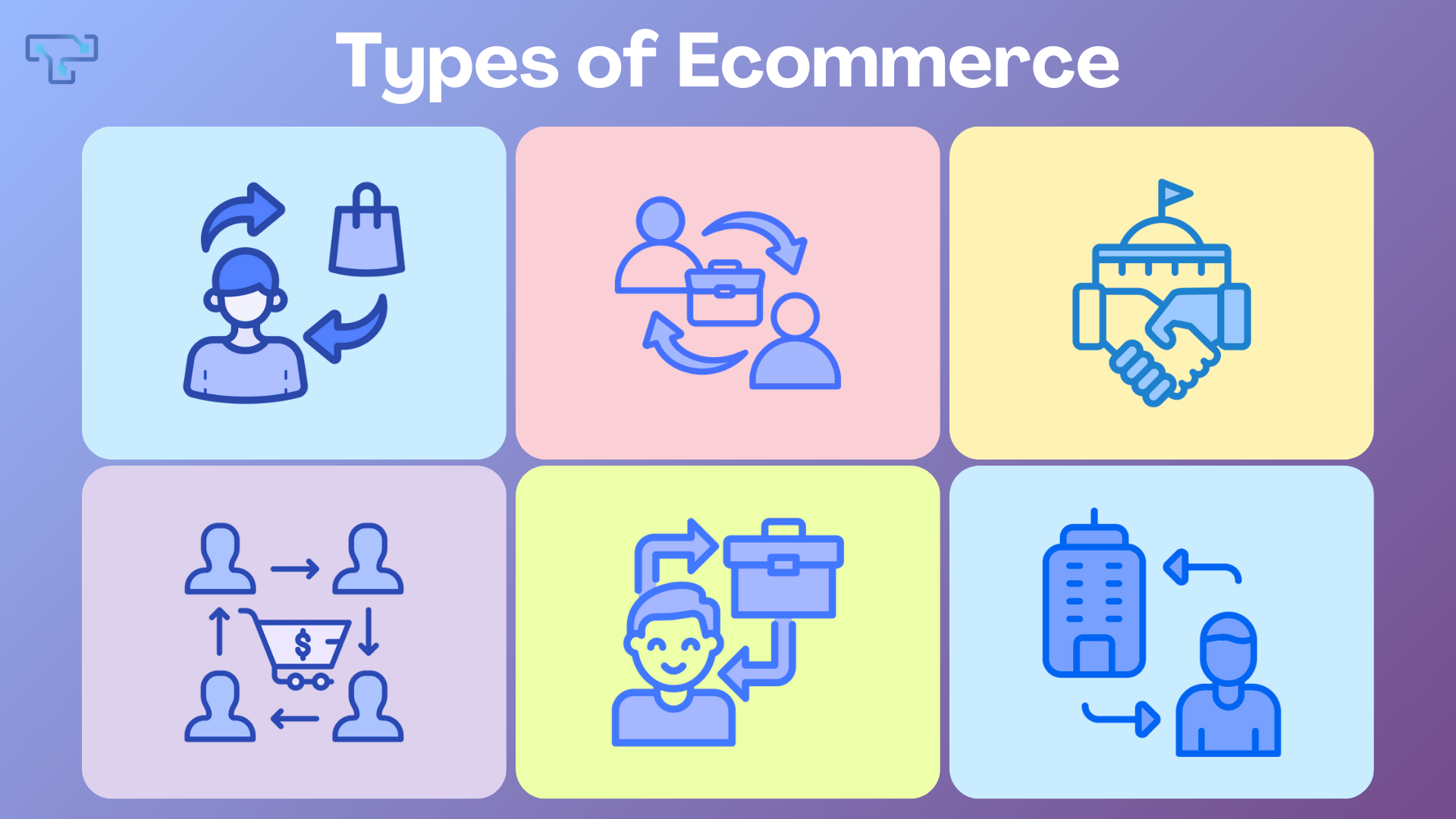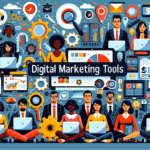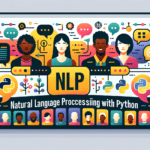Ecommerce, or electronic commerce, has revolutionized the way goods and services are bought and sold. From online storefronts to digital marketplaces, the landscape of ecommerce offers various business models, each with unique characteristics, opportunities, and challenges. Understanding these models can help businesses and entrepreneurs navigate the digital marketplace effectively. In this blog, we’ll delve into the six major types of ecommerce business models: Business-to-Consumer (B2C), Business-to-Business (B2B), Business-to-Government (B2G), Consumer-to-Consumer (C2C), Consumer-to-Business (C2B), and Consumer-to-Government (C2G).
Types of Ecommerce Business
1. Business-to-Consumer (B2C)
The Business-to-Consumer (B2C) model is perhaps the most familiar type of ecommerce. It involves businesses selling products or services directly to individual consumers. This model is epitomized by retail giants like Amazon, Walmart, and Alibaba, which offer a vast array of products from various brands. B2C businesses can either sell their products (Direct-to-Consumer or D2C) or resell products from other brands.
Key Features:
- Short Sales Cycles: B2C transactions typically have a shorter sales cycle, meaning the time between attracting a prospect and completing a sale is relatively brief.
- High Transaction Volume: B2C businesses often experience a high volume of transactions, making it essential to streamline processes for efficiency.
- Low Average Transaction Value: Individual purchases in B2C ecommerce often involve lower transaction values compared to other models.
Popular Revenue Models:
- Dropshipping: Sellers list products from third-party suppliers. When a customer makes a purchase, the product is shipped directly from the supplier to the customer.
- Subscription Services: Companies like Spotify and BarkBox offer recurring services or product deliveries, ensuring steady revenue and customer retention.
- Pre-owned/Refurbished Products: Platforms like BackMarket specialize in selling refurbished items, providing a sustainable option for consumers.
Challenges:
- Intense Competition: With relatively low startup costs, many entrepreneurs enter the B2C space, leading to fierce competition.
- Customer Acquisition: Attracting and retaining customers requires effective digital marketing strategies.
2. Business-to-Business (B2B)
The Business-to-Business (B2B) model focuses on transactions between businesses. This model often involves larger-scale purchases and longer sales cycles. B2B companies may sell directly to end-users or supply products to other businesses, which may then resell them or use them in their operations.
Key Features:
- Longer Sales Cycles: B2B transactions usually involve a more extended decision-making process, often due to the higher stakes and larger investments.
- Higher Transaction Values: B2B deals typically involve larger sums of money compared to B2C transactions.
- More Recurring Purchases: Many B2B transactions are recurring, such as subscription-based software services.
Popular Revenue Models:
- Subscription Models: B2B companies, particularly software vendors, often use subscription-based pricing to provide a steady revenue stream.
- White Labeling: Companies sell unbranded products to resellers, who then rebrand and market the products under their own name.
Challenges:
- Complex Sales Processes: The B2B sales process can be intricate, often involving multiple stakeholders and long negotiations.
- Customer Retention: Maintaining long-term relationships with business clients requires excellent service and reliability.
3. Business-to-Government (B2G)
In the Business-to-Government (B2G) model, businesses sell products or services to government agencies or public institutions. B2G transactions often start with a request for proposal (RFP), where government entities invite businesses to submit their offers for contracts.
Key Features:
- Long Sales Cycles: Government procurement processes can be lengthy, involving several stages of review and approval.
- High Transaction Values: Contracts with government agencies often involve substantial financial commitments.
- Strict Compliance Requirements: B2G transactions must adhere to rigorous regulations and standards.
Challenges:
- Bureaucracy: Navigating government bureaucracy can be challenging and slow down the sales process.
- Highly Competitive: Securing government contracts can be highly competitive due to the large number of bidders.
4. Consumer-to-Consumer (C2C)
The Consumer-to-Consumer (C2C) model facilitates transactions between individual consumers. This model is commonly seen on online marketplaces like eBay, Craigslist, and Facebook Marketplace, where consumers buy and sell goods and services directly to each other.
Key Features:
- User-Driven Transactions: C2C platforms provide the infrastructure for transactions, such as listing services and payment processing, but the transactions themselves are driven by consumers.
- Flexible Marketplace: C2C marketplaces often feature a wide range of products, from second-hand goods to unique handmade items.
Challenges:
- Quality Control: Ensuring the quality and authenticity of products can be challenging in a largely unregulated environment.
- Trust Issues: Building trust between buyers and sellers is crucial and often facilitated by the platform’s reputation and review system.
5. Consumer-to-Business (C2B)
The Consumer-to-Business (C2B) model flips the traditional ecommerce approach by allowing consumers to sell goods or services to businesses. This model includes scenarios like freelance work, where individuals offer services to companies, or platforms like Shutterstock, where contributors sell content to businesses.
Key Features:
- Diverse Offerings: C2B can involve a wide range of goods and services, from freelance graphic design to stock photography.
- Empowering Consumers: This model provides individuals with opportunities to monetize their skills or products directly.
Challenges:
- Market Saturation: The proliferation of freelancers and content creators can lead to a saturated market, making it harder to stand out.
- Payment and Compensation: Ensuring fair compensation and timely payments can be a challenge for both parties involved.
6. Consumer-to-Government (C2G)
Consumer-to-Government (C2G) transactions involve interactions between individuals and government agencies. This model includes services like paying taxes, fines, or utility bills directly through government websites.
Key Features:
- Simplified Transactions: C2G platforms streamline administrative processes, making it easier for consumers to manage their interactions with government entities.
- Enhanced Accessibility: These platforms often provide multiple payment options and improve accessibility for users.
Challenges:
- System Reliability: Government systems must be reliable and secure to handle sensitive transactions and personal data.
- User Experience: Improving the user experience in often cumbersome government interfaces is a key focus.
Conclusion
Each type of ecommerce business model offers unique opportunities and faces specific challenges. Whether you’re considering entering the B2C, B2B, B2G, C2C, C2B, or C2G space, understanding these models will help you tailor your strategies for success. As ecommerce continues to evolve, staying informed about these models and their dynamics can provide a competitive edge in the ever-changing digital marketplace.
By leveraging the strengths and addressing the challenges of each model, businesses can optimize their approach and thrive in the world of ecommerce.



